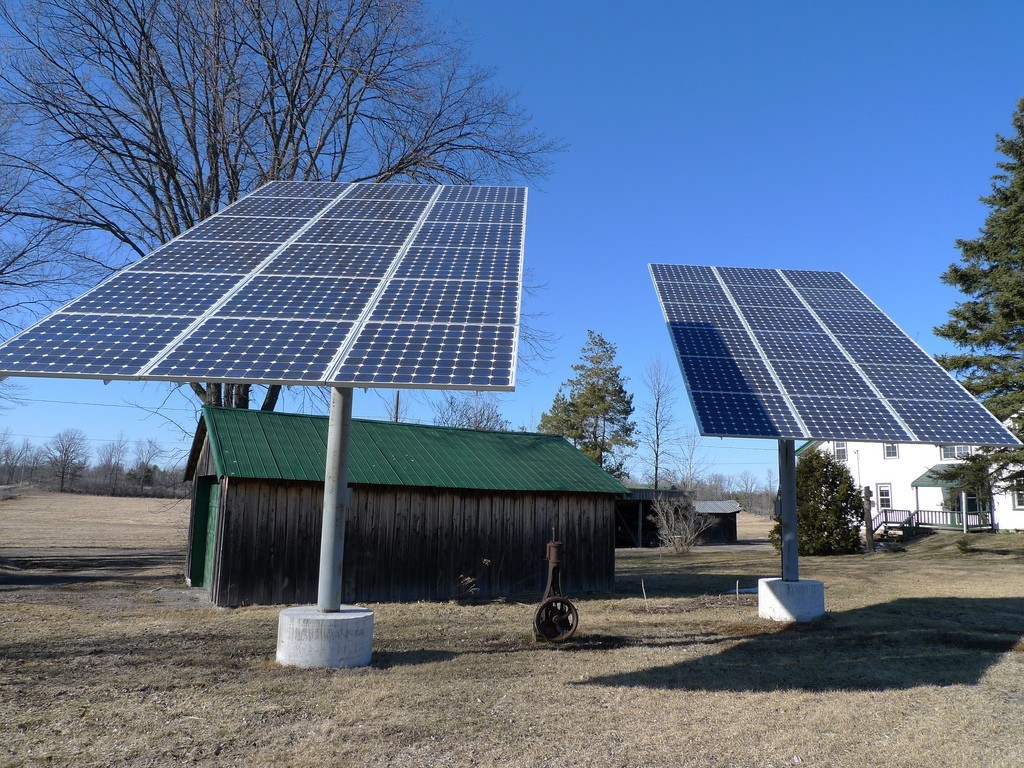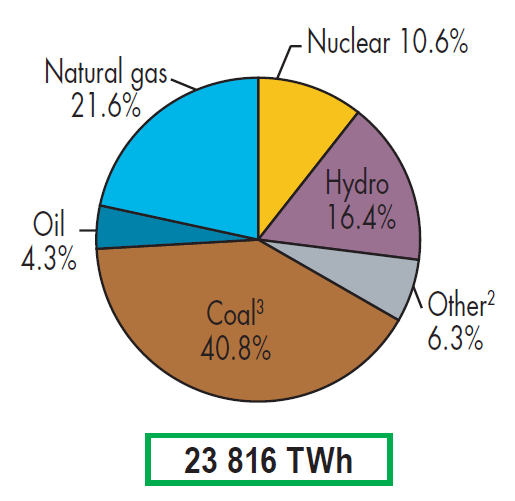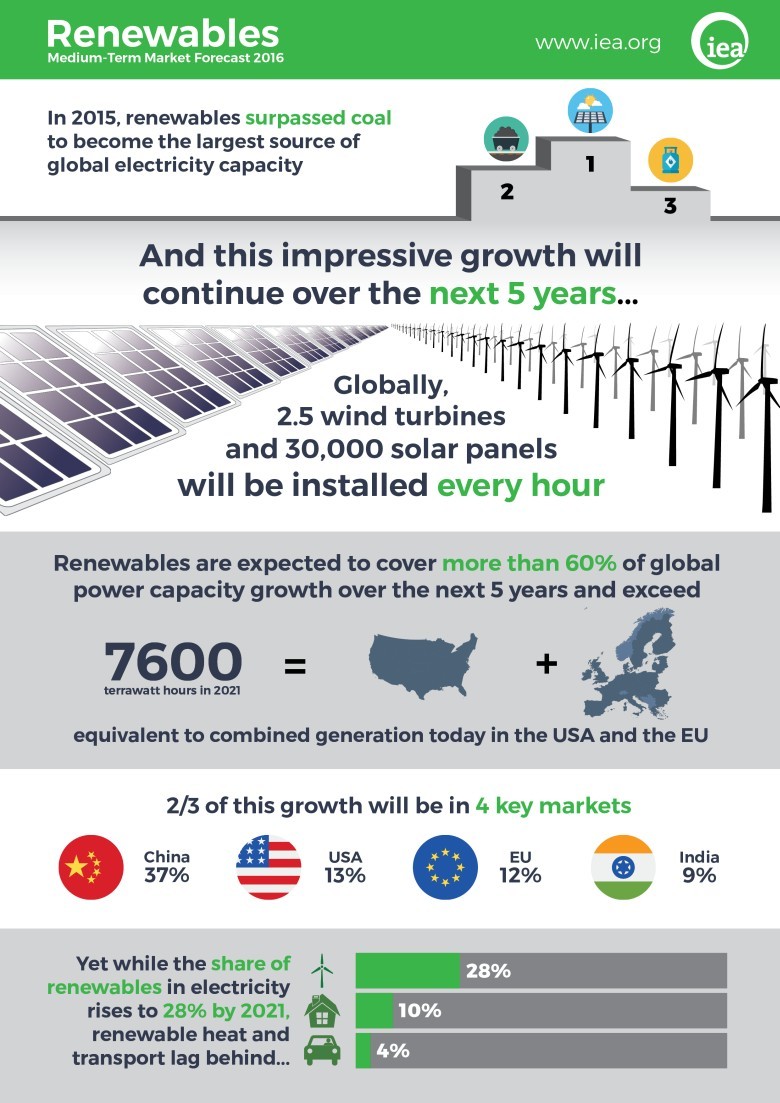Renewable energy has reached the 1st place in the world in terms of the growth rate of installed capacity among all types of fuel.

Solar panels in the village. Photo: Christine
Last year, 500,000 solar panels were installed every day in the world. In China, two wind installations are launched every hour . Before our eyes, an unprecedented "green" revolution is taking place that will radically change the balance of power in the energy market. The pace of installation of solar panels beat all records. And this is only the beginning, because the cost of wind turbines, and especially solar panels, is constantly decreasing.
Based on the latest actual data for 2015, experts of the International Energy Agency are forced to seriously revise the five-year forecast for the development of alternative energy in the world. The forecast for generated power from renewable energy sources for the next five years has been significantly increased.
“We are witnessing a transformation of global energy markets under the influence of renewable sources,” admitted Fatih Birol, executive director of the International Energy Agency. He agreed that the growth was partly caused by a drastic drop in prices for equipment for solar and wind power stations. Such prices as now "it was impossible to imagine" five years ago. Thus, the cost of installing a wind power plant from 2010 to 2015 has fallen by 30%, and the cost of large solar power plants has tripled.
')
Fossil fuels, such as coal and oil, remain the main sources of electricity generation, but the progress in the development of these archaic technologies cannot be compared with the progress in the field of solar and wind energy.
The agency predicts a further reduction in the cost of wind turbines and solar power stations over the next five years: by 15% and 25%, respectively. Apparently, this is a rather conservative estimate. It is quite possible, the forecasts will again have to be revised due to the even more rapid growth of solar and wind energy. The report Medium-Term Renewable Energy Market Report 2016 is dedicated to the time period from 2015 to 2021. The forecast for this segment was revised upwards by 13%. According to experts, the installed capacity for this segment will increase not by 730 GW, but by 825 GW. This is due to the adoption of more stringent laws of the United States, China, India and Mexico.
Over the past year in the world installed 153 GW of power in the energy sector. More than half of them are solar stations (49 GW) and wind stations (63 GW). More capacity was commissioned than some G-8 countries — for example, Canada — generate.
Solar and wind stations added more power over the year than coal, gas and nuclear power plants. Such an achievement allowed renewable natural resources to bypass coal and reach the first place in the world in terms of growth rates of installed capacity.
“Installed capacity” in alternative energy is a fairly conventional indicator. The sun does not shine around the clock, and the wind blows with variable speed in different directions. Therefore, the actual production of electricity from renewable resources is much lower than the installed capacity. According to this indicator, renewable sources are very far behind.

Electricity generation by type of fuel in 2014. Source: Key world energy statistics 2016 , International Energy Agency
To all appearances, in order to outrun fossil fuels in terms of electricity generation, it is necessary to install several times more generated power than they do now.

World electricity generation from 1971 to 2014 by type of fuel (TWh). Source: Key world energy statistics 2016 , International Energy Agency
According to the latest data from the International Energy Agency in 2015, coal provided 39% of the global electricity generation, and all renewable sources, including hydroelectric power plants, only 23%. According to the forecast, the share of renewable sources by 2021 will increase to 28%. In this case, renewable resources will generate more than 7,600 TWh - more electricity than the United States and the EU countries put together now.

The adoption of stricter legislation in some countries in support of renewable energy is associated not only with the ratification of the Paris Agreement under the UN Climate Change Convention a year earlier than predicted. This is also connected with serious environmental problems in some countries. For example, due to the strong air pollution in China, this country now seeks to actively promote alternative energy. Now approximately 40% of the new renewable energy capacity in the world falls on China (including 50% of wind turbines).
Experts warn, however, that the projected growth in alternative energy strongly depends on government support, which often changes in different countries. The unstable nature of solar and wind energy also carries certain risks for operators.
However, renewable energy stations are now being introduced more than fossil fuels around the world. In the European Union and the United States, the installed capacity of alternative energy annually exceeds the new needs of the economy. That is, now there is no sense at all to build new CHP plants on coal and gas, and you can gradually close the old ones.
In general, although the fall in prices and growth rates are very impressive, but in order to use solar and wind energy to really help achieve global environmental goals, serious steps need to be made in energy and transport, experts at the International Energy Agency say.
Source: https://habr.com/ru/post/398575/
All Articles